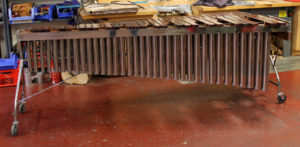In April, 2013 I received an email from Jesse Strauss, a student at Belmont University, asking for my thoughts about an article by Vida Chenoweth in which she reached some conclusions about the terms ‘xylophone’ and ‘marimba’. I have discussed the distinctions that differentiate these terms in clinics, as well as in the Xylorimba article above. Below is Jesse’s email, and my response to him about it.
JS: I am a student at Belmont University, and I also attended the LHS seminar last summer – it was a pleasure seeing your clinic in both New Jersey and Nashville!
As I was flipping through an old anthology of percussion articles from The Instrumentalist magazine, I came across one by Vida Chenoweth entitled “The Differences Among Xylophone, Marimba, and Vibraphone” (published in 1961). I immediately thought back to your clinic and wondered how Chenoweth might approach the issue, so I read on. It was a brief article, but the conclusion she reached at the end was: “In short: (1) the xylophone is a percussion instrument with a wooden keyboard; (2) the marimba is a xylophone with resonators.” In other words, it seems as though she differentiates the instruments in the same way that we differentiate a rectangle and a square.
In comparison to what I drew from your clinic – that a xylophone is technically no different except that it sounds an octave higher than written – she even makes somewhat of a contradictory statement: “Some people mistakenly identify the xylophone as a treble marimba…”. So, I am wondering what your opinion is on the matter. Is the difference that you established in your clinic one that has evolved over the years, making this very old article simply out-of-date? Or was there really once disagreement or confusion over the topic, even among professionals such as Chenoweth and others? I am also curious about your own experience as you have traveled around giving this clinic; I imagine most students are stumped by the opening question, but do most professionals seem to know the answer? Or are even they scratching their heads on the topic?
BB: Vida Chenoweth is not only a great marimbist, but also a trained and experienced (ethno)musicologist and researcher. Her definitions of the terms xylophone and marimba are in line with many classic studies of organology, which is the study of musical instrument classification. If you read books like Curt Sachs’ The History of Musical Instruments, you find the word xylophone as the principal heading for all wooden-keyed instruments. ‘Xylophone’ is a technical term, with classical Greek roots (xylo = wood; phone = sound), as I probably pointed out in my clinic. It’s similar to a term like metalophone; although xylophone is also a vernacular term that people use for many kinds of instruments, including toy glockenspiels. ‘Marimba’ derives from a Bantu root found throughout East Africa, which traveled with the Spanish slave trade to Central America, in particular Guatemala. In some organological texts the word marimba is used in a technical way to indicate the presence of resonators of any type, including the traditional African kinds made from spherical gourds. It would appear that is the view taken in Chenoweth’s article.
The first keyboard instruments made by the American percussion pioneer John Calhoun Deagan were, I believe, glockenspiels (real ones, with steel bars). The first documented xylophone he constructed was in 1893, and had only a diatonic keyboard and no resonators. The earliest marimbas manufactured in North America were produced by the J.C. Deagan company, and included a unique instrument called a Nabimba – a word Deagan himself concocted, but obviously a take on ‘marimba’. The Deagan Nabimbas were available in ranges of 2.0, 3.0, 3.5, 4.0, and 5.0 octaves (C2 to C7). Although modeled on Guatemalan marimbas, the resonators were tubular and made of brass, as opposed to the wooden box-style resonators found on Central American instruments. All of the Nabimba resonators, which were individually tunable, had the traditional African/Central American feature of a membrane mounted over a small hole (as on a kazoo), creating a buzzing effect for the sound. Clearly Nabimbas were a more modern copy of Guatemalan marimba doble instruments heard in the US during tours by the famous Hurtado family around the turn of the century. J.C. Deagan studied the physics of musical acoustics, and his company became renowned for precise tuning as well as the inclusion of resonating tubes for each bar, whether on metalophones, xylophones, or marimbas. The resulting superior sound and projection of Deagan instruments made them the standard of excellence for several decades.
Despite Chenoweth’s academically accurate comments, I stand by my original statement that both the meaning and derivation of the terms ‘xylophone’ and ‘marimba’ depend on who is using them (the terms as well as the instruments), and when. In my opinion, the modern North American xylophone is a hybrid instrument that evolved primarily through the efforts of manufacturers such as Deagan and later Leedy, as well as some player/designers who worked with them, like George Hamilton Green. Modern xylophones – at least the ones made by the major manufacturers in the US and Japan – share the same construction features with marimbas: rosewood keyboards, well-engineered frames, and precisely-tuned resonators. Some companies offer alternative overtone tuning (as introduced by Deagan in 1927); however, the main differentiating factor is transposition. A case can be made for a currently-accepted standard range for the xylophone as well as for the marimba, but ranges have changed continually over time and are really at the discretion of manufacturers and players. My 5.0 octave Deagan 268 xylophone (photo above) is a case in point, as are some instruments called for in the repertoire, such as the tenor xylophone part in Orff’s Catulli Carmina.

